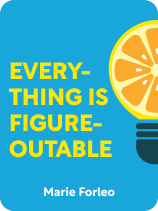

This article is an excerpt from the Shortform book guide to "Everything Is Figureoutable" by Marie Forleo. Shortform has the world's best summaries and analyses of books you should be reading.
Like this article? Sign up for a free trial here.
How do you set goals in life? How many goals should you try to accomplish at once?
Marie Forleo’s book Everything Is Figureoutable assures readers that through determination, you can achieve anything you want in life. Forleo contends that the first step is to select a single goal to focus on.
Discover how to set goals in life using Forleo’s philosophy.
Why You Should Select One Goal
If you want to learn how to set goals in life, Forleo recommends that you start by selecting one clear goal for three reasons:
1) A single goal allows you to practice implementing her philosophy. If you’re new to living as though all issues are solvable, trying to apply that philosophy to multiple challenging goals will overwhelm you. Instead, focus your energy on applying the philosophy to one goal; then, once you achieve it, use what you’ve learned to tackle your next major goal.
(Shortform note: In The One Thing, Gary Keller also recommends focusing on just one goal, or “one thing,” so you can achieve great success. He doesn’t recommend this strategy as a way to live a particular philosophy, but he agrees with Forleo that focusing on one thing will foster a domino effect: Each success will lead to another success.)
2) The process of selection forces you to stop thinking and start acting (by picking a goal), and actions will illuminate your life more than thoughts will. For example, Forleo debated for years whether she could become a dancer—but she knew she wanted to pursue dance only when she took a dance class as an adult and realized that it was a passion.
(Shortform note: In Designing Your Life, Bill Burnett and Dave Evans also emphasize the importance of acting rather than just thinking when deciding what you want to do. However, they recommend that you map out three potential directions for your life and then test them to figure out what you like and dislike about each direction. You can test by pursuing exploratory experiences, which give you first-hand knowledge of the path you’re considering—just as Forleo did when she took a dance class to test whether she wanted to pursue dance full-time. They also suggest interviewing experts in your chosen field; for example, Forleo could have interviewed a professional dancer to decide whether the dancer’s life was right for her.)
3) The more specific you are about what you want to do, the more likely you are to do it. Forleo explains that when you’re clear about your goals, you make your reticular activating system—a neural structure that sorts through stimuli and helps you decide what to focus on—more sensitive to anything related to those goals. As a result, you start to notice things in your everyday life that can help you achieve your goals, which makes you more likely to achieve them.
(Shortform note: Like Forleo, Keller states in The One Thing that having a specific goal will make you more likely to achieve it. However, this isn’t because narrowing your focus sensitizes your reticular activating system to things that help you achieve your goals. Rather, Keller explains that by narrowing your focus, you stop doing things that don’t matter—and so while you do fewer things, the things you do have greater impact and thus lead you to success. That said, this depends on your having big goals; unlike Forleo, Keller emphasizes the importance of thinking big and focusing small.)
How to Select Just One Goal
Now that you’ve learned why selecting a single goal matters, how do you do so? Forleo recommends that you start by writing down several goals for the next year. Then, select a few goals from the list, and rate how much each one matters to you on a scale of one to 10. Ignore any goals that rank below seven, as they’re not important enough to warrant your focus. If a goal is over seven, rate how hard achieving it would be on a scale of one to 10. (Rating the difficulty is not meant to discourage you but to provide clarity on what you’re signing up for and prepare you mentally.) Finally, if you’ve failed at this goal before, briefly describe why you failed and how you could act differently.
Once you have a few options, review your list and write down the single goal you’d like to spend your energy on—as Forleo notes, writing down your goal will increase the chances you’ll achieve it by 42%. This goal should be something you’re passionate about, not something society says you should want. And don’t feel pressured to take on a big goal. Your goals can be as small (or as big) as you want them to be—whether that’s mastering Chinese cuisine or attaining world peace.
Forleo says you’re more likely to stick to your goal through setbacks if you link it to a greater purpose. So while it’s OK to start pursuing a goal primarily for personal ambition, it’s better if you can link it to a loftier ambition that involves helping others. For example, your goal to master Chinese cooking might be a way to express your larger purpose of providing an environment in which your friends and family can deepen their social connections.
Once you’ve decided on your goal, Forleo recommends converting it into something specific that you can measure and act on. To start, think of three simple 10-minute things that you can do today to pursue your goal—and do them. Focus on things that are action-oriented rather than research-oriented (to avoid getting bogged down by research) and that are within your control (to ensure that success doesn’t depend on outside factors). For example, instead of “master Chinese cooking to impress my foodie friends,” write, “memorize five Chinese dishes.” Then, sign up for a Chinese cooking class instead of purchasing a cookbook.

———End of Preview———
Like what you just read? Read the rest of the world's best book summary and analysis of Marie Forleo's "Everything Is Figureoutable" at Shortform.
Here's what you'll find in our full Everything Is Figureoutable summary:
- How to apply the "everything is figureoutable" philosophy to your life
- How you can achieve your dreams and overcome all obstacles
- How to respond when you encounter criticism






